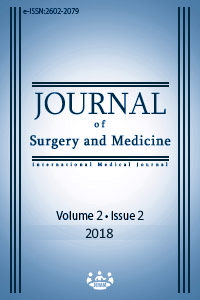Examination of the relationships between different birthweights and various gestational parameters
Keywords:
Pregnancy, Birth weight, Age, Zinc, GravidaAbstract
Aim: The aim of the study is to assess the relationship between different birth weights and some pregnancy parameters. If there is a relationship, which is the relationship between birth parameters and birth weight. What are the importance levels of these relationships?
Methods: The significant levels of the relationships for these data were statistically examined. 18-39 years old, total 276 patients were investigated, the birth weights were grouped into 7 groups were included. Multiple comparison tests were performed between the groups by weight levels for the examined parameters, and different groups were determined by testing significance levels at 95% confidence interval using Multivariate Analysis of Variance (MANOVA). For the 7 different weight groups formed, correlation analysis was performed in order to determine the correlation coefficients among the gestational parameters, i.e., age range, gravida, mode of delivery, gestational age, zinc range and live/stillbirth status and the correlation levels among these parameters were determined
Results: Birth weights decreased with increasing maternal age and gravida during pregnancy. Significant correlations were found between birth weight and examined birth parameters.
Conclusion: Based on the results of this study, it is suggested that birth weight of the patient should be taken into account and the risky birth weight patient group should be followed according to gravida, zinc range, gestational age and live/stillbirth status.
Downloads
References
Koyanagi A, Zhang J, Dagvadorj A, Hirayama F, Shibuya K, Souza JP, Gülmezoglu AM.Macrosomia in 23 developing countries: an analysis of a multicountry, facility-based, cross-sectional survey. Lancet. 2013;381:476–83.
.Leffelaar ER, Vrijkotte TG, van Eijsden M. Maternal early pregnancy vitamin D status in relation to fetal and neonatal growth: results of the multi-ethnic Amsterdam Born Children and their Development cohort. Br J Nutr. 2010;104(1):108–17.
Nkwabong E. Maternal and neonatal complications of macrosomia. Trop Doct. 2014;44:201–204.
McCormick MC. The contribution of low birth weight to infant mortality and childhood morbidity. N Eng J Med. 1985;312:82–90.
5th UNICEF. Low birth weight: country, regional and global estimates, New York. 2004. pp. 25–54.
Luhete PK, Mukuku O. Study of low birth weight associated with maternal age and parity in a population of mother and children monitored in Lubumbashi. Pan Afr Med J. 2015;20:246.
Demelash H, Motbainor A, Nigatu D, Gashaw K, Melese A. Risk factors for low birth weight in Bale zone hospitals, South-East Ethiopia: a case-control study. BMC Pregnancy Childbirth. 2015 Oct 13;15:264.
Feleke Y, Enquoselassie F. Maternal age, parity and gestational age on the size of the newborn in Addis Ababa. East Afr Med J. 1999 Aug;76(8):468-71.
Borah M, Agarwalla R. Maternal and socio-demographic determinants of low birth weight (LBW): A community-based study in a rural block of Assam. . J Postgrad Med. 2016 Jul-Sep;62(3):178-81.
Heredia-Olivera K, Munares-García O. Maternal factors associated with low birth weight Article in Spanish; Abstract available in Spanish from the publisher. Rev Med Inst Mex Seguro Soc. 2016 Sep-Oct;54(5):562-7.
Tamay AG, Güvenal T, Özgür N, Oruç Koltan S, Koyuncu FM. Retrospective Analysis of Advanced Maternal Age Pregnancies. Gynecol Obstet Reprod Med. 2011;17:83–7.
Wang H, Hu YF, Hao JH, Chen YH, Wang Y, Zhu P, et al. Maternal Serum Zinc Concentration during Pregnancy Is Inversely Associated with Risk of Preterm Birth in a Chinese Population. J Nutr. 2016 Mar;146(3):509-15.
Gebremedhin S, Enquselassie F, Umeta M. Independent and Joint Effects of Prenatal Zinc and Vitamin A Deficiencies on Birthweight in Rural Sidama, Southern Ethiopia: Prospective Cohort Study. PLoS One. 2012;7(12):e50213.
H Hu YF, Hao JH, Chen YH, Su PY, Wang Y, Yu Z, et al. Maternal zinc deficiency during pregnancy elevates the risks of fetal growth restriction: a population-based birth cohort study. Sci Rep. 2015 Jun 8;5:11262.
Shakya KL, Shrestha N, Kisiju P, Onta SR. Association of Maternal Factors with Low Birth Weight in Selected Hospitals of Nepal. J Nepal Health Res Counc. 2015 May-Aug;13(30):121-5.
Li Y, Liu QF, Zhang D, Shen Y, Ye K, Lai HL, et al. Weight gain in pregnancy, maternal age and gestational age in relation to fetal. Clin Nutr Res. 2015 Apr;4(2):104-9.
Borah M, Agarwalla R. Maternal and socio-demographic determinants of low birth weight (LBW): A community-based study in a rural block of Assam. J Postgrad Med. 2016 Jul-Sep;62(3):178-81.
Downloads
- 2612 2197
Published
Issue
Section
How to Cite
License
Copyright (c) 2018 Özgül Özgan Çelikel, Nurkan Aksoy
This work is licensed under a Creative Commons Attribution-NonCommercial-NoDerivatives 4.0 International License.















